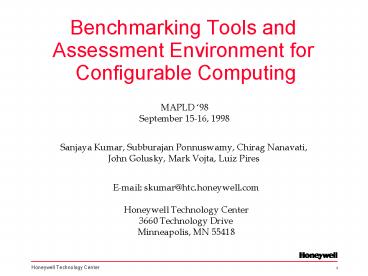Benchmarking Tools and Assessment Environment for Configurable Computing PowerPoint PPT Presentation
1 / 15
Title: Benchmarking Tools and Assessment Environment for Configurable Computing
1
Benchmarking Tools and Assessment Environment
for Configurable Computing
MAPLD 98 September 15-16, 1998
Sanjaya Kumar, Subburajan Ponnuswamy, Chirag
Nanavati, John Golusky, Mark Vojta, Luiz Pires
E-mail skumar_at_htc.honeywell.com Honeywell
Technology Center 3660 Technology
Drive Minneapolis, MN 55418
2
Program Overview
- Provides a publicly available suite of benchmarks
for evaluating configurable computing
infrastructures, both tools and architectures - Addresses benchmark specification, procedures,
metrics, and wide availability - Extends benchmarking technology to configurable
computing - Benchmarks are being implemented on a
configurable computing platform - Six benchmarks have been developed, four more
being planned
3
Unique Aspects
- Utilizes stressmarks to supplement existing
functional benchmarks - First effort to specify and measure a set of
characteristics relevant to configurable
computing systems - Addresses a broad range of configurable
architectures, beyond just single FPGAs - Approach is based on an unbiased and technology
independent benchmark specification methodology - Provides a better understanding of how
configurable computing systems relate to others
within the design space
Scalability
Interfacing
Capacity
Others
Versatility
Timing Sensitivity
4
Versatility Stressmark
- Measures an infrastructures ability to perform a
sequence of distinct, computational steps
efficiently - A space-time trade-off stressmark, possibly
employing run-time reconfiguration - Based on a wavelet image compression algorithm
- Minimum QoS must be maintained (PSNR and
compressed bit rate) - Metrics include
- Total elapsed time
- Reconfiguration overhead
- FPGA area utilized
5
Capacity Stressmark
- Measures an architectures usable capacity using
a Huffman compression algorithm - Alphabet defined with K characters, each with a
frequency f of occurrence - Huffman compression tree (at top left) and
look-up table (bottom left), based on tree,
constructed using software - Objective is to implement the largest look-up
table possible - Metrics include largest table size and look-up
speed three different approaches - Standard VHDL/automatic PR
- Standard VHDL/manual PR
- Custom
6
Timing Sensitivity Stressmark
- Measures an infrastructures ability to implement
a time-critical computation - Based on (COordinate Rotation DIgital Computer)
CORDIC algorithm for vector rotation - Pipelined stages stress both architecture and CAD
tools (place and route is an important issue) - Metrics include latency, throughput, and area
utilized two different approaches - Automatic PR
- Manual PR
CORDIC 1
MEMORY
Pre-Rotate
Read
CORDIC 2
Scale
Write
CORDIC 12
7
Interfacing Stressmark
- Measures an infrastructures ability to implement
an application on a platform consisting of GPPs,
ASPs, and FPGAs - Based on RT Parallel Benchmark Suites Constant
False Alarm Rate (CFAR) kernel - CAD tools include those that perform
hardware/software partitioning and mapping - Metrics include total elapsed time, communication
time, and speedup due to configurable elements
Hw/Sw Partitioning/Mapping CAD Tools
GPP
ASP
FPGA
8
Scalability Stressmark
Application
- Measures an infrastructures ability to implement
an application on a multi-device platform - Based on Fast Fourier Transform (complex,
fixed-point) - CAD tools include those that perform partitioning
and mapping (PM) - Metrics include total elapsed time, speedup,
efficiency, and area utilized possible
approaches - Automatic vs manual PM
- Automatic vs manual PR
Partitioning/Mapping CAD Tools
Multi-device Platform
9
CAD Benchmark
- Measures the ability of an infrastructure to
implement a time-consuming CAD application - Based on Boolean satisfiability (SAT)
- Commonly used for automatic test pattern
generation and logic synthesis/verification - Search intensive problem
- Benchmark developed in conjunction with Princeton
University - Metrics include total elapsed time and area
utilized, three different approaches - Standard automatic
- Standard manual
- Custom
10
Tools and Platform Information
- Synopsys Design Compiler on a SUN Ultra-SPARC
running Solaris 2.6 - Xilinx XACT and M1 place and route tools on a PC
containing a 166 MHz Pentium running Windows 95 - Annapolis Micro Systems WILDFORCE Board (1 Xilinx
4025, 4 Xilinx 4013 devices, 8 MBytes of memory) - Preliminary results for many of the benchmarks
tabulated, being reviewed by Dr. José Muñoz
(DARPA PM), and further refined
11
Versatility Implementation - 2D Wavelet
Atmel 6010
SUN UltraSPARC
SUN UltraSPARC
Exec Time
97 ms
226 ms
45 ms
Clock Freq
333 MHz
167 MHz
16 MHz
NA
Utilization
NA
62
- Atmel results obtained from Honeywell SASSO (Gary
Gardner) as part of NASAs RHrFPGA program - Several others within ACS community implementing
the versatility stressmark, results not available
at this time
12
Plans for Existing ACS Benchmark Suite
- Update benchmarks as needed (benchmark
specification documents, C code, VHDL code,
miscellaneous fixes) - Work with AFRL to provide a mechanism for
submitting results through the DARPA/AFRL
Benchmarking web page (www.rl.af.mil/programs/hpcb
ench), Ralph Kohler - POC - Address any suggestions that you may have to
improve the benchmarks/web site
13
Additional Benchmarks
- BM 1 Micro-kernel benchmark, based on discrete
cosine transform (DCT), working with Herman
Schmit/Seth Goldstein (CMU) - BM 2 INFOSEC benchmark, based on SHA-1,
discussing with Alan Hunsberger (NSA), Burt
Kalisky (RSA Labs), and Anant Agarwal (MIT) - BM 3 Data dependent computations benchmark,
based on electronic counter-measures application,
discussing with Rick Pancoast (Lockheed Martin) - BM 4 Variable precision arithmetic benchmark,
discussing with Rajeev Jain (UCLA) and Phillip
Duncan (Angeles Design Systems) - Seems to be a continuing need to develop
benchmarks corresponding to system level
applications - Will be implemented on an Annapolis Micro Systems
STARFIRE, PCI-based board utilizing Virtex FPGAs
14
Schedule
15
Summary
- Preliminary implementation results tabulated
(being reviewed) - Benchmarks can be downloaded www.rl.af.mil/progra
ms/hpcbench - Deliverables
- Benchmarking methodology document
- Benchmark specification documents
- C and VHDL code
- Four additional benchmarks being developed
- For more information, visit www.htc.honeywell.com
/projects/acsbench
DARPA/NASA
Design/Evaluation Tool
Relating ACS Architectures to Others
ACS Benchmarking Technology
Trade-off and Selection Technology
Demonstrating Advantages of ACS Technology
App Developers Procurement Agencies
Developers of Embedded HPC Technologies

